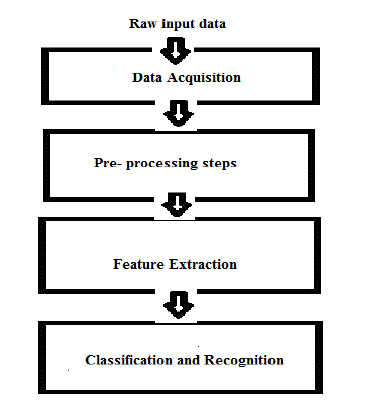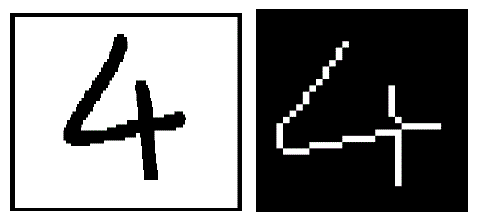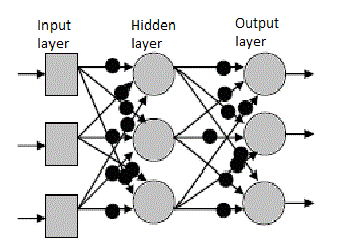Optical character recognition is a typical field of application of automatic classification methods. In this paper, we have introduced a whole new idea of recognition of isolated handwritten digits which is known to be a difficult task and still lacks a satisfactory technical solution. The present paper proposes a novel approach for recognition of handwritten digits i.e. neural network classification. Back propagation neural network is one of the simplest methods for training multilayer neural networks. In this paper, we designed a back propagated neural network and trained it with a set of handwritten digits. The average success rates of recognition of all digits are 91.2%.
Keywords |
| optical character recognition, neural network, classification, back propagation. |
I. INTRODUCTION |
| Handwritten character recognition is a field of image processing as well as pattern recognition. There are two
approaches for the pattern recognition such as statistical and structural [1]. In statistical approach, the ser of
characteristic measurements of the input data is generated on the statistical basis and is assigned to one of the n classes.
The structural description of the object is based on the interconnections and interrelationships of features of input data.
In general, both approaches are widely used in the pattern recognition. |
| Since the handwriting of different writers is different, building a general recognition system that would recognize all
characters with good reliability is not possible in every application. Thus recognition systems are developed to achieve
reliable performances to the specific applications. In particular, the handwritten digit recognition has been applied to
recognize amounts written on checks for banks and zip codes on envelops for postal services. Handwritten digit
recognition system can be divided into four stages as shown in fig. 1. |
| Data acquisition |
| Pre-processing |
| Feature extraction |
| Classification |
| An overview of the paper is as follows. In section II, a character modelling and pre-processing steps are discussed. In
section III, the feature extraction technique is described. In section IV, a brief review of neural network and back
propagation algorithm for training neural networks are discussed. In section V, experimental analysis is provided.
Finally in section VI, conclusion and future scope is described. |
II. PRE-PROCESSING STEPS |
| In offline character recognition system, image which is recognized is captured by the optical scanner. The efficiency
of the input data analysis can be improved by pre processing the scanned images of the characters [2]. Pre-processing
phase aims to extract relevant textual parts of the character images by performing various operations such as
binarization, noise reduction, thinning, skeletonization, normalization and compression. |
| Image is distorted due to the noise introduced by image acquisition such as optical scanning and binarization. It is
impossible to remove such distortion but can be decreased by various noise reduction techniques. These techniques can
be categorized into three major groups such as filtering using convolution operations, morphological operations using
logical operations and noise modelling [3]. When image is captured, it is in the grey scale format i.e. in the form of
pixel density value between 0 to 255. In binarization, the grey scale image is thresholded and converted into binarized
image in the form of 0 and 1. There are two methods to binarize the image such as global thresholding and local
thresholding. In global thresholding only one threshold value is chosen for entire document [4]. Local thresholding uses
different threshold values for each pixel with the help of local area information [5]. |
| Skeletonization is the process of elimination or removal of the extra pixels of the character which are not belonging
to the backbone of the character of an image. Normalization is the process of converting random sized image into the
standard sized image. Here we have normalized image to 32 *32 size to avoid the inter class variation among
characters. |
III. FEATURE EXTRACTION |
| Since many classifiers can not process the raw images or data efficiently, extracting the relevant information of the
data is needed. Feature extraction is the step that aims to extract relevant information b reducing the dimension of the
data. The performance of the classifiers depends on quality of the feature extracted from the data. In character
recognition system, the commonly used features are statistical, structural, moments and global transformations. |
| For extracting the features and executing the classification steps, the frame of digit is required after narrowing them.
This frame includes the important data of input digits and the unnecessary data of an image is removed. For finding the
narrowed frame of digits, the coordinates of pixels of foreground in farthest left, right, up and down side are found. In
such conventional feature extraction technique [6], if a line passes through a pixel (foreground), then the corresponding
pixel will be given value one (1). If line does not pass a pixel (background), then it is taken as zero (0). |
IV. CLASSIFICATION |
| The term neural network was traditionally used to refer to network or circuit of biological neurons. The modern
usage of the term often refers to artificial neural networks (ANN) or simulated neural networks (SNN). Artificial neural
network is an interconnected group of natural or artificial neurons that uses mathematical or computational model for
information processing. In most of the cases an artificial neural network is an adaptive system that changes its structure
based on external or internal information that flows through the network. In more practical terms, neural networks are
non-linear, statistical data modeling or decision making tool. They can be used to model complex relationships between
inputs and outputs or to find patterns in the data. |
| We have implemented a multilayer feed forward neural network with one hidden layer as shown in fig. 3. The
topology of neural network comprises of 1024 input nodes, 50 hidden nodes, and 10 output nodes. We have
implemented back propagation algorithm for training the network. |
V. EXPERIMENTAL ANALYSIS |
| During preprocessing, each character is normalized into 32 x 32 pixel image, along with noise / spurs removal. For
these normalized images, we have been extracted feature values by conventional technique. Thus for 32 x 32 image,
number of input nodes to the neural network are 1024 and learning has been implemented using back propagation
algorithm. For training purpose we have used 25 samples of each class and testing applied to all 50 images.
The digit 0 is assigned as class 1, digit 1 as class 2 and so on up to digit 9 as class 10. |
VI. CONCLUSION AND FUTURE SCOPE |
| In this work we implemented a neural network for offline recognition of handwritten isolated digits. The
skeletonized and normalized binary pixels of digits were used as inputs of multilayer perceptron network. An
experimental result shows that conventional features with back propagation network yields good classification accuracy
of 100% and recognition accuracy of 91.2%.The work can be extended to increase the results by using or adding some
more relevant features. A lot of efforts have been made to get higher accuracy and there is tremendous scope of
improving recognition accuracy by developing new feature extraction techniques or modifying the existing feature
extraction techniques. |
Tables at a glance |
 |
| Table 1 |
|
| |
Figures at a glance |
 |
 |
 |
| Figure 1 |
Figure 2 |
Figure 3 |
|
| |
References |
- Tuan Trung Nguyen, “Adaptive Classifier Construction: An Approach to Handwritten Digit Recognition”, J.J. Alpigini et al. (Eds.): RSCTC, LNAI 2475, Springer-Verlag Berlin Heidelberg, pp. 578–585, 2002.
- T. Vasudev, G Hemanthkumar, P. Nagabhushan, “Transformation of Arc-Form-Text to Linear Form Text Suitable for OCR”, Pattern Recognition Letters, vol. 28, issue 16, pp.2343-2351, 2007.
- Sonka M., Hlavac V., Boyle R., “Image Processing Analysis and Machine Vision”, 2nd Edition, 1999.
- Chen M. Y., Kundu A., Zhou J., “Offline Handwritten Word Recognition Using HMM Type Stochastic Network”, IEEE Transaction of Pattern Analysis and Machine Intelligence, 16, 481-496, 1994.
- Saula J., Pietikainen M., “Adaptive Document Image Binarization”, Pattern Recognition, vol. 33, issue 2, 2000.
- Dayashankar Singh, Sanjay Kr. Singh, Dr. (Mrs.) MaitreyeeDutta, “Handwritten Character Recognition Using Twelve Directional Feature Input and Neural Network”, International Journal of Computer Applications, Volume 1 – No. 3, 2010.
- Anita Pal, Dayashankar Singh “Handwritten English Character Recognition Using Neural Network” International Journal of Computer Science and Communication vol.1 No. 2, pp 141-144, 2010.
- M. K. Mohammed Altahaf, M. B. Begum “Handwritten Characters Pattern Recognition Using Neural Networks” International Conference on Computing and Control Engineering, 2012.
|